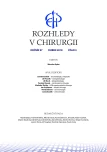Intra-operative fluorescence angiography of colorectal anastomotic perfusion: a technical aspects
Authors:
L. Martínek; F. Pazdírek; J. Hoch; P. Kocian
Authors‘ workplace:
Chirurgická klinika 2. LF Univerzity Karlovy a FN Motol, Praha
Published in:
Rozhl. Chir., 2018, roč. 97, č. 4, s. 167-171.
Category:
Original articles
Overview
Introduction:
Anastomotic leak after colorectal surgery is a serious complication. Tissue perfusion plays a key role for anastomotic healing. Fluorescence angiography with indocyanine green under near-infrared excitation allows a real-time perfusion assessment. The aim of this study was to evaluate the feasibility and the potential benefit of intraoperative assessment of anastomotic perfusion in colorectal surgery using indocyanine green-enhanced fluorescence in near-infrared light.
Methods:
53 patients with primary anastomosis after elective colon or rectum resection were enrolled between 1 January 2016 and 31 January 2017. Near-infrared fluorescence angiography with indocyanine green was performed to assess tissue perfusion. The data of patient characteristics, data of surgery, data related to perioperative fluorescence angiography and postoperative complications were collected prospectively.
Results:
Intraoperative fluorescence angiography was successful in 52 patients (98%). There were no adverse effects related to procedure. The mean time from indocyanine green application to visible fluorescence was 35 seconds, the mean added procedure time was 5 minutes. The best contrast was achieved by reducing the dose to 0.1 mg/kg. In 5 patients (9%), fluorescence angiography resulted in a change of the surgical plan. In two cases, the resection line was moved proximally, in two cases the anastomosis was corrected and in one case perfect perfusion of the anastomosis contributed to the decision to abandon the planned protective ileostomy. There was no postoperative anastomotic leak.
Conclusions:
Perioperative assessment of anastomotic perfusion in colorectal surgery by use of indocyanine green in near-infrared light is technically feasible with the potential to alter surgical strategy (including avoidance of defunctioning stoma) and to reduce the anastomotic leak rate.
Key words:
anastomotic leak − colorectal surgery − fluorescence angiography − indocyanine green
Sources
1. Paun BC, Cassie S, MacLean AR, et al. Postoperative complications following surgery for rectal cancer. Ann Surg 2010;251 : 807−18.
2. Mizrahi I, Wexner SD. Clinical role of fluorescence imaging in colorectal surgery – a review. Expert Rev Med Devices 2017;14 : 75−82.
3. Jafari MD, Wexner SD, Martz JE, et al. Perfusion assessment in laparoscopic left-sided/anterior resection (PILLAR II): a multi-institutional study. J Am Coll Surg 2015;220 : 82−92.
4. Ris F, Hompes R, Cunningham C, et al. Near-infrared (NIR) perfusion angiography in minimally invasive colorectal surgery. Surg Endosc 2014;28 : 2221−6.
5. Boni L, David G, Dionigi G, et al. Indocyanine green-enhanced fluorescence to assess bowel perfusion during laparoscopic colorectal resection. Surg Endosc 2016;30 : 2736−42.
6. Hellan M, Spinoglio G, Pigazzi A, et al. The influence of fluorescence imaging on the location of bowel transection during robotic left-sided colorectal surgery. Surg Endosc 2014;28 : 1695−1702.
7. Sherwinter DA, Gallagher J, Donkar T. Intra-operative transanal near infrared imaging of colorectal anastomotic perfusion: a feasibility study. Colorectal Dis 2013;15 : 91−6.
8. Kudszus S, Roesel C, Schachtrupp A, et al. Intraoperative laser fluorescence angiography in colorectal surgery: a noninvasive analysis to reduce the rate of anastomotic leakage. Langenbeck’s Arch Surg 2010;395 : 1025−30.
9. Newman MI, Jack MC, Samson MC. SPY-Q analysis toolkit values potentially predict mastectomy flap necrosis. Ann Plast Surg 2013;70 : 595−8.
10. Damen N, Spilsbury K, Levitt M, et al. Anastomotic leaks in colorectal surgery. ANZ J Surg 2017;84 : 763−8.
11. Benya R, Quintana J, Brundage B. Adverse reactions to indocyanine green: a case report and a review of the literature. Cathet Cardiovasc Diagn 1989;17 : 231−3.
12. Boni L, David G, Mangano A, et al. Clinical applications of indocyanine green (ICG) enhanced fluorescence in laparoscopic surgery. Surg Endosc 2015;29 : 2046−55.
13. Alander JT, Kaartinen I, Laakso A, et al. A review of indocyanine green fluorescent imaging in surgery. Int J Biomed Imaging 2012. Available from: doi: 10.1155/2012/940585
14. Škrovina M, Benčurik V, Holášková E, et al. Fluorescence angiography in the detection of anastomotic perfusion during rectal and sigmoid resection – preliminary report. Rozhl Chir 2016;95 : 354−8.
15. Jafari MD, Lee KH, Halabi WJ, et al. The use of indocyanine green fluorescence to assess anastomotic perfusion during robotic assisted laparoscopic rectal surgery. Surgical Endosc 2013;27 : 3003−8.
16. Ris F, Buchs NC, Morel P. Discriminatory influence of Pinpoint perfusion imaging on diversion ileostomy after laparoscopic low anterior resection. Colorectal Dis 2015;17 Suppl 3 : 29−31.
17. Tortorelli AP, Alfieri S, Sanchez AM, et al. Anastomotic leakage after anterior resection for rectal cancer with mesorectal excision: incidence, risk factors, and management. Am Surg 2015;81 : 41−7.
Labels
Surgery Orthopaedics Trauma surgeryArticle was published in
Perspectives in Surgery

2018 Issue 4
Most read in this issue
- Surgical treatment of midshaft clavicular fractures using intramedullary nail
- Artificial bowel sphincter ten years later
- Liver surgery for colorectal liver metastases
- Radiotherapy in the treatment of rectal cancer − is it time to move on?
